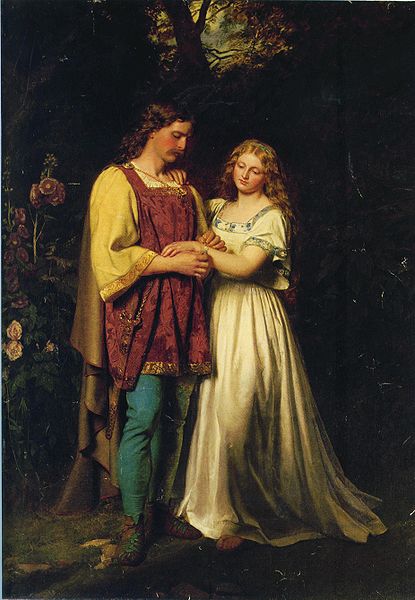Cymbeline, also known as The Tragedie of Cymbeline or Cymbeline, King of Britain, is a play by William Shakespeare set in Ancient Britain and based on legends that formed part of the Matter of Britain concerning the early historical Celtic British King Cunobeline. Although it is listed as a tragedy in the First Folio, modern critics often classify Cymbeline as a romance or even a comedy. Like Othello and The Winter's Tale, it deals with the themes of innocence and jealousy. While the precise date of composition remains unknown, the play was certainly produced as early as 1611.
Imogen in her bedchamber in Act II, scene ii, when Iachimo witnesses the mole under her breast. Painting by Wilhelm Ferdinand Souchon, 1872
Posthumus and Imogen by John Faed.
Iachimo stealing Imogen's bracelet, Act II Scene ii. Illustration by Louis Rhead, designed for an edition of Lamb's Tales, copyrighted 1918.
Imogen Discovered in the Cave of Belarius by George Dawe.
William Shakespeare was an English playwright, poet, and actor. He is widely regarded as the greatest writer in the English language and the world's pre-eminent dramatist. He is often called England's national poet and the "Bard of Avon". His extant works, including collaborations, consist of some 39 plays, 154 sonnets, three long narrative poems, and a few other verses, some of uncertain authorship. His plays have been translated into every major living language and are performed more often than those of any other playwright. Shakespeare remains arguably the most influential writer in the English language, and his works continue to be studied and reinterpreted.
The Chandos portrait, likely Shakespeare, early 17th century
John Shakespeare's house, believed to be Shakespeare's birthplace, in Stratford-upon-Avon
Shakespeare's coat of arms, from the 1602 book The book of coates and creasts. Promptuarium armorum. It features spears as a pun on the family name.
Shakespeare's funerary monument in Stratford-upon-Avon








